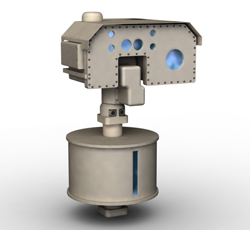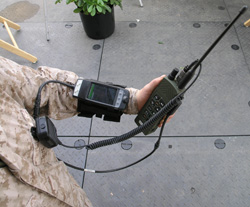Threat Detector
A new Surveillance Detection System (
SDS) capable of near real-time, 360-degree detection of optical threats identifies when friendly forces are being monitored or targeted by cameras, binoculars, sniper scopes or other optical means. The system was recently demonstrated on a
U.S. government test range and successfully completed field testing over the past year. The SDS can be adapted to meet specific customer needs, including tracking of counter-surveillance; snipers; intelligence, surveillance and reconnaissance; and improvised explosive devices. It also provides the range and Global Positioning System location threats in a prioritized database built on real-time target interrogations.
The SDS design combines advanced sensing and processing components in a compact, lightweight and environmentally rugged package.
Autonomous Biodetection
The U.S. Department of Homeland Security (DHS) is set to begin field testing a new generation of autonomous biodetection instruments as part of the BioWatch Gen-3 program. The department will test 12 of the Next Gen Automated Detection System (NG-ADS) units in outdoor and indoor locations in a major U.S. city for several months to determine its readiness for future deployment. Operating 24 hours per day, 365 days per year, the biodetectors represent a key technological component of Northrop Grumman's candidate BioWatch Gen-3 system. BioWatch Gen-3 is envisioned by DHS as a fully autonomous network of biodetectors located in population centers around the U.S. that will continuously monitor the air for agents of biological concern. By rapidly identifying biothreats, the biodetection systems provide an early warning capability that a biological incident has occurred. This warning gives the nation's public health and safety officials the opportunity to reduce exposure, distribute medication sooner and proactively manage the response to a biothreat.
Warfighter Touch Screen
The U.S. Army’s Communications-Electronics Research, Development and Engineering Center (CERDEC) recently announced an agreement with Microsoft to explore touch-screen capabilities for the warfighter. The COMET project aims to dive into some of the most promising aspects of touch-enabled computing. The project team has been working with various multitouch hardware platforms, including Microsoft Surface, Windows 7, Android and iPad, and is reaching out to industry vendors to follow the future of touch-enabling computing hardware. With the help of universities, fellow governmental research agencies and other partners, the team is working on a framework of touch-enabled software components for reusability in generic military applications while also working with interested agencies and units to find some of the specific military applications for touch-driven and collaborative multiuser software.
Wearable Computer
The
Itronix GD300 wearable computer combines commercial global positioning and communications technology with battlefield-rugged computing. The fully rugged, arm- or chest-worn computer weighs less than 8 ounces and operates like an ultrasensitive commercial Global Positioning System (GPS) unit or, with the click of a cable, interfaces with tactical radios for secure access to the tactical network. Hosting the open-architecture, Android-based operating system, the GD300 easily accommodates current and emerging applications for warfighters at all command levels. Designed for the dismounted soldier, the system operates for more than eight hours, providing the soldier access to real-time information. Built by General Dynamics, the GD300 is ruggedized for harsh environments, uses a high-gain antenna architecture to ensure GPS signal reception and features an intuitive design for easy operation.
Operating in two distinct modes, the GD300 serves as a stand-alone GPS device or, when connected to a tactical radio, performs as a tactical mission computer. The GD300 supports commercially available stand-alone applications or military apps such as the Tactical Ground Reporting System. When connected to a tactical radio, the lightweight GD300 enables warfighters to securely communicate, share information and collaborate while on the move.





Comments